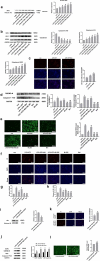Melatonin alleviates lipopolysaccharide (LPS) / adenosine triphosphate (ATP)-induced pyroptosis in rat alveolar Type II cells (RLE-6TN) through nuclear factor erythroid 2-related factor 2 (Nrf2)-driven reactive oxygen species (ROS) downregulation
- PMID: 35109747
- PMCID: PMC8973817
- DOI: 10.1080/21655979.2021.2018981
Melatonin alleviates lipopolysaccharide (LPS) / adenosine triphosphate (ATP)-induced pyroptosis in rat alveolar Type II cells (RLE-6TN) through nuclear factor erythroid 2-related factor 2 (Nrf2)-driven reactive oxygen species (ROS) downregulation
Abstract
Pyroptosis has pivotal parts within disease development, rendering this attractive mechanism for novel therapeutics. This investigation aimed at analyzing melatonin roles within pyroptosis together with related mechanistics. RLE-6TN cultures were exposed to varying LPS doses for 4.5 h followed by concomitant culturing in the presence of ATP (5 mM) for 0.5 h to induce injury, and the roles of melatonin, N-Acety-L-cysteine (NAC - a ROS scavenger), ML385 (specific Nrf2 inhibitor) were examined. Apoptosis analysis was performed through lactate dehydrogenase (LDH) activity assays, together with propidium iodide (PI) stain-assay. Intracellular ROS were quantified through 2, 7-dichlorodihydrofluorescein diacetate (DCFH-DA). Pyrolysis-associated proteins, such as nucleotide-binding oligomerization domain-like receptor containing pyrin domain 3 (NLRP3), apoptosis-associated speck-like protein containing a CARD (ASC), cysteine aspartate-specific protease-1 P20 (Caspase-1 P20), gasdermin D-N (GSDMD-N), and mature interleukin-1β (IL-1β), were identified through Western blotting. Dataset outcomes demonstrated LPS/ATP induce RLE-6TN cell pyroptosis, while melatonin alleviated this phenomenon, visualized through increased cell survival rate, reduction of LDH discharge and PI+ cellular count. Moreover, melatonin effectively reduced NLRP3 inflammasome triggering in RLE-6TN cells. Meanwhile, this study demonstrated melatonin thwarting over NLRP3 inflammasome triggering was depending on ROS. In addition, this study found that melatonin activated Nrf2/Heme Oxygenase-1 (HO-1) pathway, with pyroptotic-inhibiting function of melatonin was reverted through a bespoke Nrf2-inhibitor and siNrf2. In summary, this study concluded that melatonin prevents RLE-6TN cellular pyroptosis through Nrf2-triggered ROS downregulation.
Keywords: Melatonin; NLRP3 inflammasome; Nrf2; RLE-6TN; ROS; pyroptosis.
Conflict of interest statement
No potential conflict of interest was reported by the author(s).
Figures





Similar articles
-
Melatonin Attenuates LPS-Induced Acute Depressive-Like Behaviors and Microglial NLRP3 Inflammasome Activation Through the SIRT1/Nrf2 Pathway.Front Immunol. 2019 Jul 2;10:1511. doi: 10.3389/fimmu.2019.01511. eCollection 2019. Front Immunol. 2019. PMID: 31327964 Free PMC article.
-
Lipopolysaccharide (LPS) Aggravates High Glucose- and Hypoxia/Reoxygenation-Induced Injury through Activating ROS-Dependent NLRP3 Inflammasome-Mediated Pyroptosis in H9C2 Cardiomyocytes.J Diabetes Res. 2019 Feb 17;2019:8151836. doi: 10.1155/2019/8151836. eCollection 2019. J Diabetes Res. 2019. PMID: 30911553 Free PMC article.
-
Dimethyl itaconate inhibits LPS‑induced microglia inflammation and inflammasome‑mediated pyroptosis via inducing autophagy and regulating the Nrf‑2/HO‑1 signaling pathway.Mol Med Rep. 2021 Sep;24(3):672. doi: 10.3892/mmr.2021.12311. Epub 2021 Jul 23. Mol Med Rep. 2021. PMID: 34296312 Free PMC article.
-
The Crosstalk between Nrf2 and Inflammasomes.Int J Mol Sci. 2018 Feb 13;19(2):562. doi: 10.3390/ijms19020562. Int J Mol Sci. 2018. PMID: 29438305 Free PMC article. Review.
-
Role of pyroptosis in spinal cord injury and its therapeutic implications.J Adv Res. 2020 Aug 18;28:97-109. doi: 10.1016/j.jare.2020.08.004. eCollection 2021 Feb. J Adv Res. 2020. PMID: 33364048 Free PMC article. Review.
Cited by
-
Methionine deficiency inhibited pyroptosis in primary hepatocytes of grass carp (Ctenopharyngodon idella): possibly via activating the ROS-AMPK-autophagy axis.J Anim Sci Biotechnol. 2024 Sep 2;15(1):116. doi: 10.1186/s40104-024-01069-6. J Anim Sci Biotechnol. 2024. PMID: 39218924 Free PMC article.
-
Hydrogen Regulates Ulcerative Colitis by Affecting the Intestinal Redox Environment.J Inflamm Res. 2024 Feb 12;17:933-945. doi: 10.2147/JIR.S445152. eCollection 2024. J Inflamm Res. 2024. PMID: 38370464 Free PMC article. Review.
-
The Role of Pyroptosis and Autophagy in Ischemia Reperfusion Injury.Biomolecules. 2022 Jul 21;12(7):1010. doi: 10.3390/biom12071010. Biomolecules. 2022. PMID: 35883566 Free PMC article. Review.
-
Long non-coding RNA ZNFX1 antisense 1 (ZFAS1) suppresses anti-oxidative stress in chondrocytes during osteoarthritis by sponging microRNA-1323.Bioengineered. 2022 May;13(5):13188-13200. doi: 10.1080/21655979.2022.2074770. Bioengineered. 2022. PMID: 35635081 Free PMC article.
References
-
- Shao XF, Li B, Shen J, et al. Ghrelin alleviates traumatic brain injury-induced acute lung injury through pyroptosis/NF-κB pathway. Int Immunopharmacol. 2020;79:106175. - PubMed
-
- Lamkanfi M, Dixit VM.. Inflammasomes and their roles in health and disease. Annu Rev Cell Dev Biol. 2012;28:137–161. - PubMed
MeSH terms
Substances
LinkOut - more resources
Full Text Sources
Research Materials
Miscellaneous
